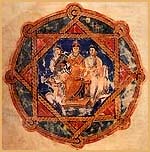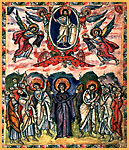|
Manuscript production and Illumination
In the second and third centuries, the book of
bound pages (c odex)
began to replace the traditional papyrus scroll. It was a
durable and easy to use vehicle for both text and illustrations.
The sixth-century Vienna Dioskorides is the most luxurious
of Byzantine scientific manuscripts. It contains several works
of medicine and pharmacology, and numerous miniatures, mostly
full-page illustrations of plants in alphabetical order, as
well as pictures of snakes, insects, animals and birds. At
the beginning of the manuscript, four miniatures with representations
of the centaur Chiron, Galen and Dioscorides are references
to the history of pharmacology. Another pictures
Anicia Juliana,
to whom the manuscript was dedicated, enthroned between the odex)
began to replace the traditional papyrus scroll. It was a
durable and easy to use vehicle for both text and illustrations.
The sixth-century Vienna Dioskorides is the most luxurious
of Byzantine scientific manuscripts. It contains several works
of medicine and pharmacology, and numerous miniatures, mostly
full-page illustrations of plants in alphabetical order, as
well as pictures of snakes, insects, animals and birds. At
the beginning of the manuscript, four miniatures with representations
of the centaur Chiron, Galen and Dioscorides are references
to the history of pharmacology. Another pictures
Anicia Juliana,
to whom the manuscript was dedicated, enthroned between the
 personnifications of Magnanimity and Prudence, and dropping
gold on a copy of the book held by a
putto. Within
the octagonal frame, an inscription in silver letters praises
Juliana for a church she built for the people of Honoratae,
near Constantinople, sometime before 512. The book was probably
their gift to Juliana. Putti are pictured building this church
on the spandrels of the octagon. Among Early Byzantine religious
manuscripts, the Rossano Gospel, Sinope Gospel and Vienna
Genesis are the finest, with beautiful illustrations of the
gospel and Septuagint narrative on luxurious purple-dyed parchment.
The latter feature may indicate an imperial patron, since
purple was a color reserved for the emperor. All three are
attributed to the sixth century. The Rabbula Gospel is a Syriac
manuscript, completed in 586 by the scribe Rabbula in the
monastery of Zagba in Mesopotamia.
personnifications of Magnanimity and Prudence, and dropping
gold on a copy of the book held by a
putto. Within
the octagonal frame, an inscription in silver letters praises
Juliana for a church she built for the people of Honoratae,
near Constantinople, sometime before 512. The book was probably
their gift to Juliana. Putti are pictured building this church
on the spandrels of the octagon. Among Early Byzantine religious
manuscripts, the Rossano Gospel, Sinope Gospel and Vienna
Genesis are the finest, with beautiful illustrations of the
gospel and Septuagint narrative on luxurious purple-dyed parchment.
The latter feature may indicate an imperial patron, since
purple was a color reserved for the emperor. All three are
attributed to the sixth century. The Rabbula Gospel is a Syriac
manuscript, completed in 586 by the scribe Rabbula in the
monastery of Zagba in Mesopotamia.
|